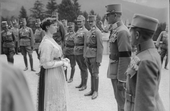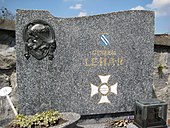Anton Lehár
Anton Freiherr von Lehár (born February 21, 1876 in Ödenburg ; † November 12, 1962 in Vienna ), also called Baron Anton von Lehár, was an Austro-Hungarian colonel . His brother was the composer Franz Lehár .
Career start
Lehár was the son of the Kapellmeister in Infantry Regiment No. 50 of the Austro-Hungarian Army Franz Lehár (senior) (1838–1898) and Christine Neubrandt (1849–1906). He went to school in Pressburg , Prague and Vienna . He attended the infantry cadet school in Vienna, which he graduated in 1893. First he served in his father's regiment, where he served as a second lieutenant until 1894 and as a first lieutenant between 1894 and 1898. Between 1897 and 1899 Lehár attended the kuk war school in Vienna, where he received general staff training. He then held various trainer positions until the beginning of the First World War , including a. in the kuk army shooting school in Bruck an der Leitha . In November 1913 he was promoted to major after passing the general staff examination for senior officers.
First World War

After the outbreak of World War I, Lehár was given the rank of major in command of the 2nd Battalion of Honvéd Infantry Regiment No. 13 , which he commanded at the beginning of September 1914 during the battle in Galicia near the town of Chodel (south of Lublin , northwest of Kraśnik ) against troops of the Russian 4th Army . His battalion was part of the Landsturm Infantry Brigade 100 under the command of Georg Mihálcsics von Stolacz and thus the "Kummer" army group. His battalion held the particularly hard-fought course of the front in the area of hill 229 immediately to the left of the troops of the 1st Austro-Hungarian Army under the command of General Viktor Dankl . Lehár later received the Knight's Cross of the Military Maria Theresa Order for his work . He was wounded on September 7, 1914 in the fighting for Lublin.
After his recovery, he served in the Tyrolean Defense Command in 1915. After his appointment as lieutenant colonel in September 1915, Lehár was deployed to the Italian front at his own request . There he commanded the "Lehar Army Group" in the Etschtal - Rovereto subsection , consisting of Tyrolean Standschützen and Bosniaks .
In June 1916 he was transferred to the Technical Military Committee , where he took on responsibility for infantry and cavalry armament and, in particular, promoted the arming of companies with machine guns . From the autumn of 1917 operations followed on the Eastern Front in the Bukovina (command of the independent Landsturmbataillon 150) and in the office of Hermann Kövess von Kövesshaza . In February 1918 Lehár was transferred to Infantry Regiment No. 106 , which had emerged from the Kuk Infantry Regiment "Freiherr von Schikofsky" No. 83 , and which he commanded in the battles of the Piave . He stayed in this regiment until the end of the war. In May 1918 he was made a colonel and received the Golden Medal of Bravery for Officers.
In August 1918, Lehár was awarded the Knight's Cross of the Military Maria Theresa Order by the Emperor in the Villa Wartholz for his services in the battle of Chodel . Due to the statutes of the order, Lehár was also raised to the hereditary baron status and received (as a Hungarian) the title of baron. At the end of the war, Lehár led the regiment completely back to the garrison of Szombathely and Kőszeg in Hungary .
In the Polish-Ukrainian war , Colonel Lehár was involved in the fighting over Lviv , which was held by Polish residents, in late 1918 / early 1919 as the commander of a western Ukrainian infantry division .
In the spring of 1919 he gathered a battalion of Hungarian emigrants to secure southern Styria against the Yugoslavs near Radkersburg . In August 1919 he was given command of the royal Hungarian infantry division of Szombathély by Reich administrator Admiral Miklos Horthy and appointed military commander of western Hungary with promotion to major general.
Hungary
After his release from the Austro-Hungarian Army, Lehár decided to stay in Hungary and fight for the restoration of the monarchy.
In 1921, on the advice of Lehár, who considered the situation favorable for a return of the emperor , Charles I traveled incognito by car across Austria to Budapest and asked the imperial administrator Miklós Horthy to resign, which he refused. On October 20, 1921, Karl flew with his wife Zita from Bourbon-Parma to Sopron, where few troops loyal to the king were stationed under the leadership of Ostenburg . However, they did not receive knowledge of the king's return by telegram until October 21. In Budaörs , a suburb of Budapest, they encountered troops loyal to the government on October 23 . 19 soldiers were killed in this clash. Since there was a danger of civil war, Karl gave up against the opinion of his military advisers. While Charles I went into exile in Madeira , Lehár fled through Czechoslovakia to Germany .
Business life

With the help of his brother Franz Lehár, he became director of the Society of Authors, Composers and Music Publishers in Berlin in 1926 . After the seizure of power of the Nazis , he returned to Vienna.

There he founded the Chodel music publishing company , which did not generate any profits. In 1935 he bought an estate in Theresienfeld near Wiener Neustadt . After the "Anschluss" of Austria in March 1938, Lehár was ordered by the Gestapo to Vienna and was there under observation until the liberation of Vienna. After the death of his brother Franz in October 1948, Lehár took over the administration of his estate in the Lehár-Schikaneder-Schlössl Vienna-Nußdorf and the protection of the copyrights of his works. In 1973 his autobiography was published.
Honors
- April 1909: Military Merit Cross
- October 1909: Certificate of approval from the Imperial and Royal War Ministry
- August 1911: Officer's Cross of the Star of Romania
- April 1913: Military Merit Medal in Bronze (Signum Laudis)
- April 1913: Ottoman Order of Osmanje 4th class
- October 1914: Order of the Iron Crown 3rd class with war decorations; after being wounded near Lublin on September 7, 1914
- October 1915: Prussian Iron Cross 2nd class
- May 1918: Great Gold Medal of Bravery for Officers; for the command of the IR 106 on the Piave
- August 1918: Knight's Cross of the Military Maria Theresa Order (and nobility); for holding point 229 at Chodel (Poland) on September 2, 1914 as commander of the 2nd Baon of the Honved-LStIR. 13
Namesake
In commemoration, one of the two decommissioned cohorts in 2011 from the Theresian Military Academy in Wiener Neustadt chose the name “Vintage Freiherr von Lehar”.
Fonts
- Regiment 106. A contribution to the history of the Kaiser. and royal. Infantry Regiment No. 106. Paul Kaltschmid, Vienna, undated
- Our mother. Vienna [u. a.], 1930
- Peter Broucek (Ed.): Memories. Counter-revolution and attempts at restoration in Hungary 1918–1921. Publishing house for history and politics. Vienna 1973, ISBN 3-7028-0069-7 .
literature
- Georg Reichlin-Meldegg: General and Parzival. GM Anton Freiherr von Lehar, the composer's brother. Commander of the restoration attempts by Emperor Charles 1918–1921. Ares Verlag, Graz 2012. ISBN 978-3-902732-08-8
Web links
- Anton Freiherr von Lehár on austro-hungarian-army.co.uk
- Vintage badge "Freiherr von Lehár". Austrian Armed Forces
- Entry on Anton Lehár in the Austria Forum (in the Austrian Personal Lexicon of the First and Second Republic )
Individual evidence
- ^ City of Vienna: Vienna 1948 reports from October 1948: October 26, 1948: Mayor Körner on the death of Franz Lehar ( German ) Retrieved on January 4, 2009.
- ^ Peter Broucek (Ed.), Anton Lehar: Memories. Counter-revolution and attempts at restoration in Hungary 1918–1921. Publishing house for history and politics. Vienna 1973, ISBN 3-7028-0069-7 , p. 59.
- ↑ a b Peter Broucek (Ed.), Anton Lehar: Memories. Counter-revolution and attempts at restoration in Hungary 1918–1921. Publishing house for history and politics. Vienna 1973, ISBN 3-7028-0069-7 , p. 12.
- ^ Peter Broucek (Ed.), Anton Lehar: Memories. Counter-revolution and attempts at restoration in Hungary 1918–1921. Publishing house for history and politics. Vienna 1973, ISBN 3-7028-0069-7 , p. 14.
- ^ Peter Broucek (Ed.), Anton Lehar: Memories. Counter-revolution and attempts at restoration in Hungary 1918–1921. Publishing house for history and politics. Vienna 1973, ISBN 3-7028-0069-7 , pp. 16-18.
- ^ Paul Lendvai : The Hungarians. A millennium of winners in defeats. Bertelsmann, Munich 1999, ISBN 3-570-00218-7 , p. 426. Peter Broucek (Ed.), Anton Lehar: Memories. Counter-revolution and attempts at restoration in Hungary 1918–1921. Publishing house for history and politics. Vienna 1973, ISBN 3-7028-0069-7 , pp. 28–32.
- ↑ Gary Potter: Ven. Emperor Karl I of Austria and Empress Zita.
- ↑ The "revision" sank in blood and tears. The May 25, 2001 standard.
- ^ Paul Lendvai: The Hungarians. A millennium of winners in defeats. Bertelsmann, Munich 1999, ISBN 3-570-00218-7 , p. 425.
- ^ Peter Broucek (Ed.), Anton Lehar: Memories. Counter-revolution and attempts at restoration in Hungary 1918–1921. Publishing house for history and politics. Vienna 1973, ISBN 3-7028-0069-7 , p. 19.
- ^ Peter Broucek (Ed.), Anton Lehar: Memories. Counter-revolution and attempts at restoration in Hungary 1918–1921. Publishing house for history and politics. Vienna 1973, ISBN 3-7028-0069-7 , pp. 19-21.
| personal data | |
|---|---|
| SURNAME | Lehár, Anton |
| ALTERNATIVE NAMES | Lehár, Anton Freiherr von; Lehár, Baron Anton von |
| BRIEF DESCRIPTION | Austro-Hungarian military |
| DATE OF BIRTH | February 21, 1876 |
| PLACE OF BIRTH | Ödenburg |
| DATE OF DEATH | November 12, 1962 |
| Place of death | Vienna |



